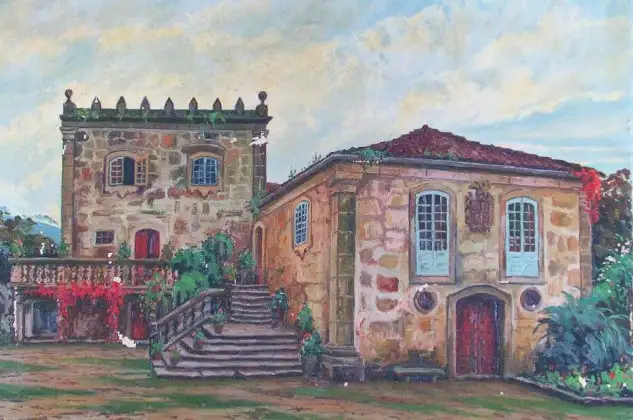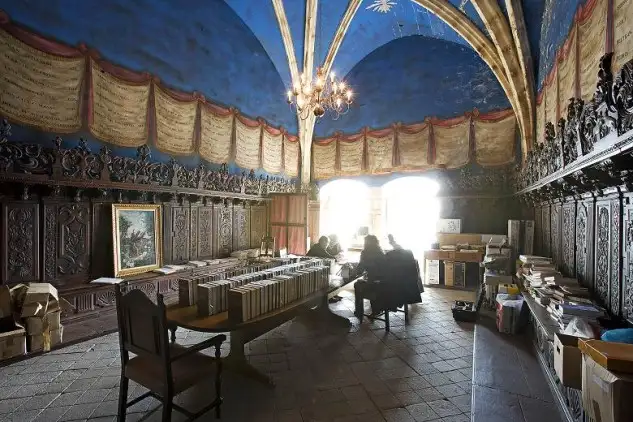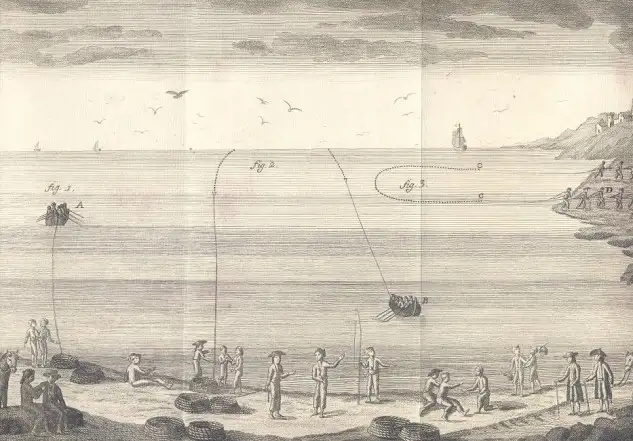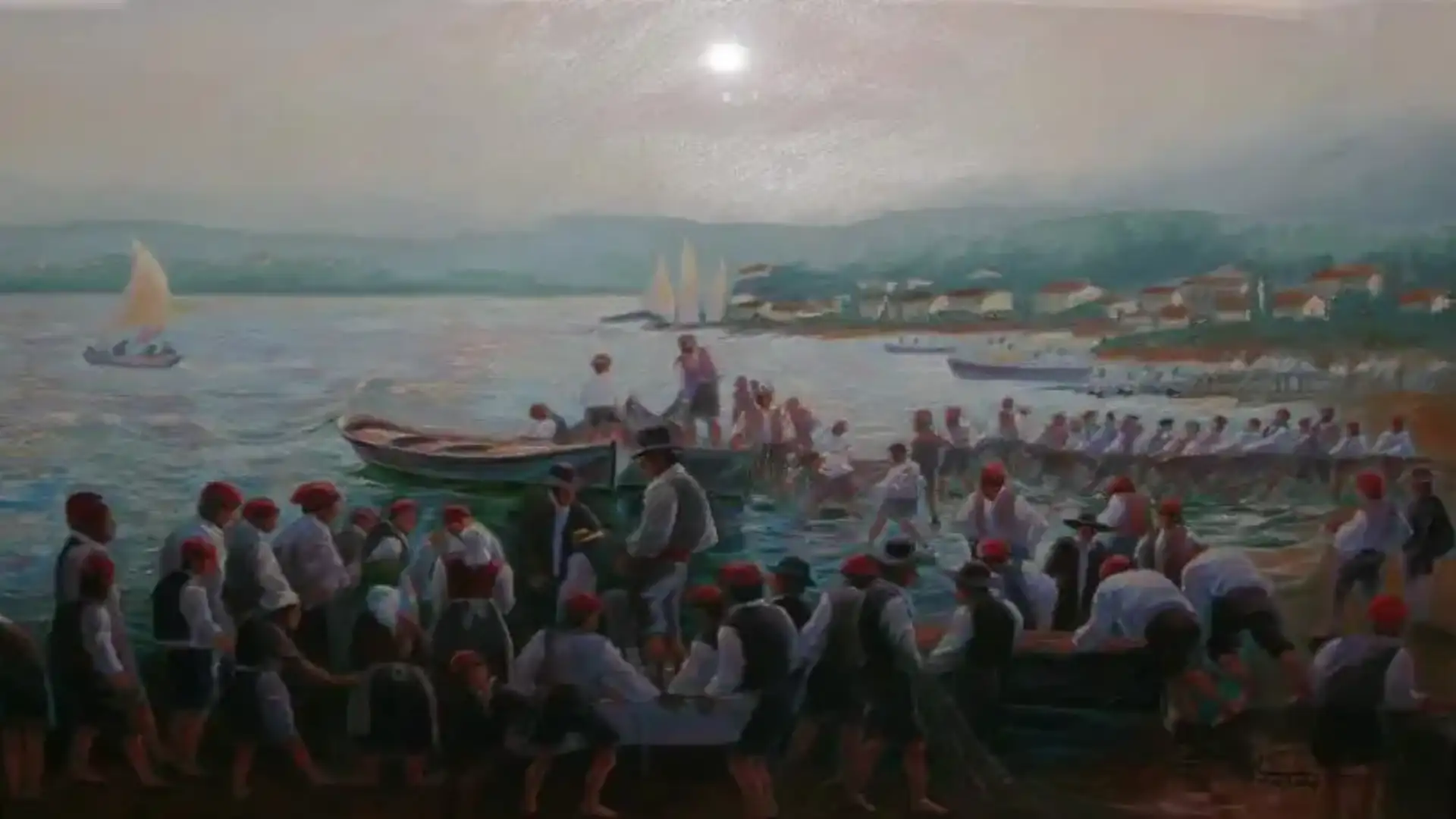
The invasion of the barretinas: 70 years of Catalan penetration in the Rías Baixas (1750-1820)
The invasion of the barretinas: 70 years of Catalan penetration in the Rías Baixas (1750-1820)

Oil reproduction of an engraving of Doré del Siglo XIX which is located in the Provincial Museum of Pontevedra. The piece was commissioned and presented to the RCN de Vigo, at the end of the "Galegos e Catalans Exhibition" (Caixanova Week 2008), curated by Manuel Pedro Seoane and Juan Marcet. The engraving plays a scene of Catalan fishermen, including barretina, fishing in the Ria de Pontevedra, at the beginning of the 19th century
It's an experience I used to do from a very young age: Do you know that maybe Vigo is one of the cities with the largest number of inhabitants of Catalans?... and they answered me. Is this a joke?... and took the guidance of the Telefonic Company and said: "For example, let's go to the letter you want and see the handouts,..."and my interlocutor was impressed: Massó, Coma, Serrat, Pujol, Colomer, Barret, Marcet, Bolíbar, Detrell, Fabregas, Palau, Haga, Puch, Crusat, Escofet, Barreras, Torres, Millet, Carsi, Curbera, Puig, Portanet, Duran... and so hundreds and hundreds,But what happened? Bonaventura Marcó del Pont i Bori, natural Calella de Palafrugell As it is moving forward for two reasons: the first to see the possibilities of the anchovy industrial fishing sector, because in the Mediterranean there was what is said to be shanty. The other reason is to establish a Corsaria Base in Vigo at the service of Charles III and then Charles IV.
Vigo passed from 250 inhabitants! that only Marked the Pont had 5,000 employees!, thousands of his compatriots settled in Vigo mainly, the most attractive and best area of Vigo is still called the Barrio de los Catalanes. There they set up the saloon factories first and you'll get them later. Between the Salazón and the Corso Vigo left the being a people to pray to reach in the 19th century, the 50,000 souls!. This is my story of Vigo, one of the most important cities of descendants of Catalan citizens: "THE INVISION OF THE BARRETIN'
1750
The first expeditions of Catalan industrialists to the Rías Baixas are beginning to arrive. In the first phase the ports of Bueu and Cangas are their settlements. This first wave of "Invasion of the Barretins" lasts approximately until the year 1780. Between this phase and the second phase until well into the 19th century, it is estimated that about 25000 Catalans came to the Rías Baixas. What forms one of the most important events in the socio-economic history of Vigo and its area of influence. In these times Pontevedra led the production of the Galician alfolis by the volume of salt sold, followed by Betanzos, Padron, Redondela, Viveiro, Vilagarcía and Vigo. With the arrival of the Catalans in a few years Vigo assumes leadership in a clear way. Its great innovation is the use of the "boar arts" with which lances of 40 tons were achieved,..., phenomenal catches that filled the "chancas" of the salting factories, precursors of the preserved ones.
1758
He settled in Vigo Bonaventura Marcó del Pont i Borí, born in the gerundense town of Calella de Palafrugell twenty years earlier. He is the first Catalan to set his residence in Vigo. In the Vigo Business Census, it is recorded as "sardine trafficker" which to date was only composed of "individuals of indigenous stretch," as stated in the Vigo City Council Records in its folio 101, in 1767.
1759
The Barcelona Francisco Puig arrives at Vigo, who is going to be Marcó del Pont's most important partner. It is the beginning of the numerous list of Catalan families that in these years come to Vigo, highlighting among others the Félix Buch, Juan Buch and Narciso Buch (Calella), Antonio Carbó and Benito Carreras (Tossa de Mar), Bartolomé Dalmau (Reus), Francisco Ducasi and Félix Ferrer (Barcelona), Juam Gumá (Sitges), Francisco Meltra, Gabriel Serafín, Francisco Solá and Pedro Nonell (Mataró).
1760
The Fábregas family is located in the "Areal de las Monxas" and are consecrated in the office of salted sardina, in order to export it to Catalonia. The Fabregas coming from Barcelona have three sardine factories, one in Teis, one in Aldán and the third in Moimente (Hio). The latter sell it years later to French Torunelle for 10,000 reais.
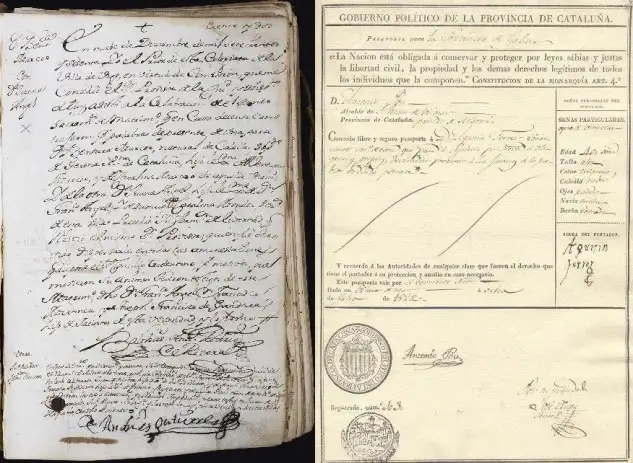
To the left image of the Libro-record of the Church of Santa María de Vigo that is located in the diocesan Archive of the Cathedral of Tui. It reflects the act of marriage between Marcó del Pont and Juana Angel Méndez (the grandmother of Admiral Méndez Núñez) in 1860. He witnessed this link, José de la Gandara (Javier de la Gandara is his descendant). To the right a Pasapelle- Salvocuela Catalan early in the 19th century for your commercial trips to Vigo (Seoane & Prado Collection).
1762
In the memoirs of Beliardy, which was Consul General of France in Madrid, interesting reports are reflected on the incipient activity of Catalan industrialists in Galicia: "Galician fishermen failed until the arrival of the Catalans to obtain the due benefit, making great profit, of a formidable fishing wealth." This document is available in the Bibliotheque Nationale in Paris.
1764
Carlos Guixeras natural de Barcelona is located in Vigo. He was one of the most important professionals on the Mediterranean fish market. His son Carlos later joined the Catalan also Ramón Carreras, and formed a company that owned a sardine salting factory in the Areal de Vigo Quarter.
1765
The Consul of England in Barcelona in a memorial to the Board of Trade of London, reports that the British merchants established in Barcelona attribute the great decline experienced in Catalonia by imports of salted fish from the British domains, mainly those carried out by the Catalan industrialists, which enjoy a higher quality in production than the British.
1766
The Catalans denounce "the strong enemy who professes the mariners of the village and port of Cangas from the beginning." They are cited as ravages caused by the Mariners in their seedlings (by blinding them with stones), and they burned all their arts and their ships. They were the first years in which the pioneers from the Mediterranean had to endure a strong anti-Katalan reaction from the native tidal groups. In Bueu, the "Catalan promoter" José Caminada, the owner of Mataró, is in court against the sailors of that port for "having ruined and ground the alpendre that he had on the sea side for the sardine room." Then he would desist from his demand and withdraw it, claiming that he "desists peace, calm and quiet as a good Christian."
1770
On this occasion they protest the Fabregas and the Guixeras, against the sailors of Cangas for the enormous difficulties they have in being able to fish in the Ria de Vigo. A large part of the "Catalan promoter" are located in different villages of the Ria, but others choose because their stay in Galicia for the time of the coast of the sardine, usually returning to what they called their Catalan nation. A son of the first Fabregas in Vigo, Vicente Fabregas, was the one who continued his father's business based on the salting of the sardine and its export to Catalonia, based on the Barrio del Areal.
1775
It is decided to lift the prohibition on the use of "jabegas" in the Rias Bajas. This year the Catalan fishermen already operated with more than a thousand nases in the Ria de Vigo and several jabegas, capturing ten thousand sardine. The Catalans added these catches to their acquisitions in other ports, and exported them mainly to Catalonia. These exports were estimated to exceed the value of about 5 million reais of those of those years.
1778
The struggle between the native fishermen and the "Catalan promoter" for the use of the "jabega" were times when he ruled in Spain Charles III. The initiative of the Catalans and their technology much more developed than that used in Galicia, is able to start up new salazonera companies and with them they would make Vigo the first place for fishing and the large supply market in all of Spain and other countries.
1779
The position of the Galician fisherman, anchored in his ancient practices, is criticized in the London Staph, not daring to promote salons because it was not profitable in the short term. The articulist Martínez del Villar apostillaba then: "If all of Spain were Catalonia they would have much to feel the main trading powers of Europe," regarding the advantages of having erected the Catalans so many salt factories in Vigo and other ports of the Galician coast.
1780
The second wave of the Catalans began, among which many came to simulate their activity in the fishery with the import and export of wines, liquors and spirits. In those years they moved a volume of the order of 60,000 and 80,000 pipas of salted sardine and wine. These were the foundations that the Catalans put in Vigo, so that the Viguese economy would grow extraordinarily in the years to come. In the Arenal Quarter there are numerous Catalan industrialists who settle down, some for rent and others build their own homes. This unusual growth causes urban chaos in the area, having to intervene the City of Vigo in the proximity of many houses to the sea, to the extent that it makes it impossible to move through the carriages and postcards.
1783
José Caminada, who simulated its fisheries in the Rias Bajas with which it carried out from other ports of Andalusia and Levante, had bases in Vigo, Hío and Aldán, had several ships dedicated to trade, case of the "patache" of 30 tons "San José," arming this year on the occasion of the war with England a corsary that would be very renowned, the "Gallardo." It had several houses in property in the Barrio del Areal vigués, and numerous farms in the parishes of Santiago de Vigo, Teis and Chapela. The huge crisis that erupted with Spain at the end of the century, caused Caminada to have to mortgage its great heritage in order to get its companies out.
1785
The Barrio del Areal, known until those years as the Arenal de la Barxa, gradually takes its new nickname: "Barrio de los Catalanes" reaches 110 neighbors and there are numerous salazoneras factories that are installed there. In the coming years, it brings together the whole of the fish industry, a practice that alternates with the wine and spirit stores of the Catalan industrialists, which end up being installed with their families in this area, by giving them the "Vigo neighborhood card."
1787
A conlicto for the eruption of the Catalans in El Berbés, and in a municipal act you can read: "They intend to go to the Berbés Bank, where they buy the fish to extract it from this Reyno, taking it to the Arena de las Monjas, far from the Villa and thus deprive the supply of its natural and even from the province." The Marquis de Valladares, the Supreme Prosecutor, warns the Catalans and other citizens that in the Arenal of the Monxas and Barrio de la Calzada, they will not be allowed to proceed to burial. The City of Vigo provides for a fine of two ducates for offenders, as well as for the prosecution and placing of them in public prison.
1791
During the biennium 1790-1791, the Vigo salazonera industries consume 30,000 salt flanges, the most important consumption of Galicia. He was followed by Ares (26,700), Vilagarcía (26,110), El Ferrol (22,200) and Muros (21,215). This salt consumption, as far as Vigo is concerned, was fired in the following years, even the Catalan Roura Sala and the Roojano Llorente Romero, both located in the Barrio del Areal, to request permission from the State to import from other salt countries to supply the Viguese factories. In those years the Royal Hacienda of the Monarchy was the monopolizer of salt. Vigo then produced as the leader of the Spanish market 80,000 sardine pipes, and 20,000 sardine fat pipes. In the Ria de Vigo, more than 15,000 women and 5,000 men were working in the sardine industry in the last years of this century. Figures that some authors almost double. The emoluments of women two and a half reals per day of work,..., that of men was more than double.
1792
Growth at that time continues at a good pace in the Viguese neighborhoods of O Berbés, Faltora and Salgueiral, but the highest rate is the Catalans' Quarter. The establishment of so many salting factories has been the maximum driving factor for the growth of the neighborhood,... so that it has been made again from twenty years to this part,..., the chronicles of the time prayed.
1796
Ignacio Raich de Arenys de Mar who was also a prominent exporter of sardine, this year gets the Real Patente in favor of its 40-ton "San Antonio y Animas" bergantin to export goods from Vigo to the Cantábrico and Mediterranean.
1799
This is the relationship in thousands of sardines, of the production of the industries of the main Catalan entrepreneurs in Vigo: José Luck (16.109), Narciso Buch (9.268), José Ventell (4.870), Juan Torrens (4.507), Zenón Curbera (4.166), Fidel Muntaner (4.156), Joseph Roura Sala (3.093), Francisco Pascual (2.994), Miguel Filiú Doset (2.342), Bonaventura Marcón del Pont (1.965), Carlos Enriez (1.990), (1.990). Other Catalans appear below with minor productions on the list of Nicolás Buch, Ramón Carreras, Mateo Catá, Miguel Crusat, Crsitóbal Domemech, Pablo Domenech, Juan Sophet, Francisco Guinovart, Juan Gumá, Carlos Guixeras, Carlos de Haga, Félix Ilas, Antonio Martí, Salvador Massot, Isidro Moreu, Francisco Plá, Francisco Puig, Ramón Pujals, Ignacio Raich, Pedro Sabater, Isidro Sanz, Ventura Sanz, Grau Tapas and Fernando Vandrell among others. A total of over 40,000,000 sardines, which in three years would increase to 45,000,000 annual production.
1800
José Lluch becomes one of the most prestigious figures in local trade. This year the "boar" weapon "La Virgen del Carmen," popularly known for "El Palangrero" of 20 tons. Lluch years later the City Council would achieve the grant of the supply of liquors and spirits in Vigo. The industrialist of Sant Pol de Mar de Girona, José Roura and Sala, owns important salazoneras industries based in the Barrio del Areal and the port of Beluso. Roura, like Lluch, also set up one of his ships in corso, the "Santa Victoria" alias "La Fortuna." Juan Escofet, born in the Barcelona town of Santa Eulalia de Baneres, forms an important company in which are partners his countrymen Sacarrant, Torrens and the Badell brothers. This company also had factories in Vigo, Ferrol, Pontedeume and Vilanova and Geltru.
1801
Francisco Xané of Barcelona is the commissioner of several important Catalan companies for the export of salazones and other Galician products. Zenón Curbera arrives in Vigo and is one of the largest industrialists of the time in the sardine world. Curbera founded one of the main tanning industries of that time. Gaspar Masetti, for his part, has arrived at the City Council for 20,000 reais the supply of spirits to Vigo and is later appointed Commander of the Urban Militia.
1802
Miguel Safons de Vilanova i la Geltru had his house in the Barrio de la Calzada de Teis, and is dedicated especially to the import of cod and the dispatch of Catalan wines to the port of El Ferrol. José Jorge alters the alcohol traffic with the fish bowl, and comes to have two factories in Our Lady of the Guide (Teis@-@ Vigo). Other emigrants from Catalonia that come to Vigo in those years are Andrés Llauger (Arenys de Mar), Félix Illas, Juan Millet and José Puig (Blanes), José Puch (Calella), Juan Vallonrat (Cornellá), Miguel Crusat (Sitges), Carlos Cerret (Tarragona) and Sebastián Carsi (Vilanova i la Geltrú).
1803
The export record for sardines in Vigo is reached until then, exceeding the figure of 124,000,000 pieces. The Viguese warehouses were up until this year stunned with goods, in the fear of navigation for the war with England. The "best customer of Vigo by sea" was the Port of Barcelona, which absorbed 67.5% of the exported, followed by that of Alicante with 23.6% and that of Cartagena with 7.4%.
1810
In April of this year the Superior Board of Defense of the Kingdom of Galicia on the occasion of the fight against the Napoleonic invader, gives the following tax quotas, in real of the Vellon: Marcó del Pont (20,000), Viuda de López (10,000), Pedro Abeleyra (6,000), José Lluch (5,000), Buch Arnao (4,000), Francisco Pascual (4,000), Carlos de Haga (3,500), Salvador Masot (2,800), Francisco Menéndez (2,800), Juan Escofet (2,500), Ignacio and Rárón (2,500), and Május (2500).
1816
Salvador Massó Palau natural de Blanes (Girona) is installed in Bueu and with her children Salvador and Gaspar creates a salting factory, "Salvador Massó e Hijos". From there the growth of the Conservera Massó will be constant, will become "Massó Brothers." and then become a public limited company. They open factories in Cangas, Avilés and Barbate. The history of this conservatory reaches the end of the last 20th century.
Manuel Pedro Seoane Cordal
© 2024 Nautica Digital Europe - www.nauticadigital.eu


